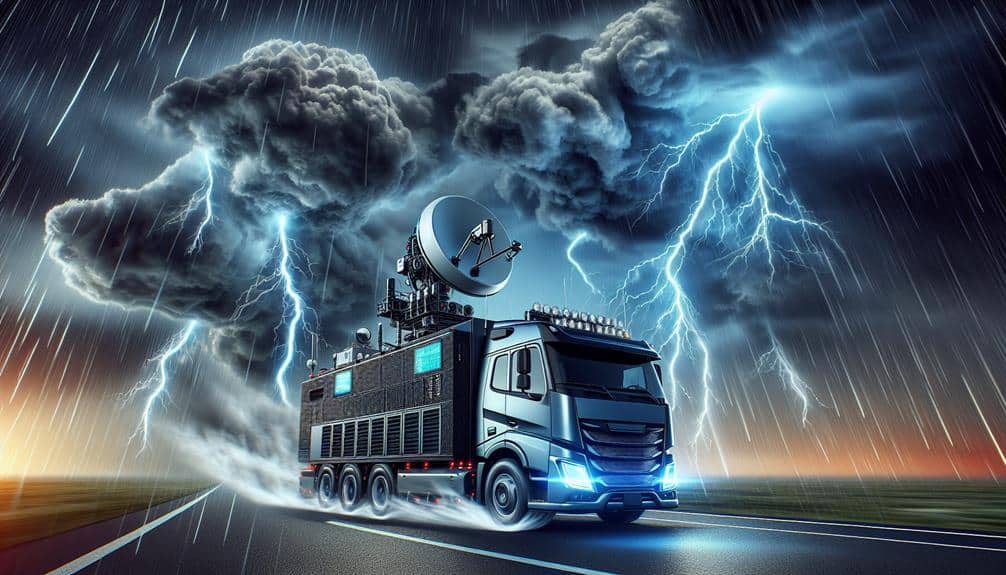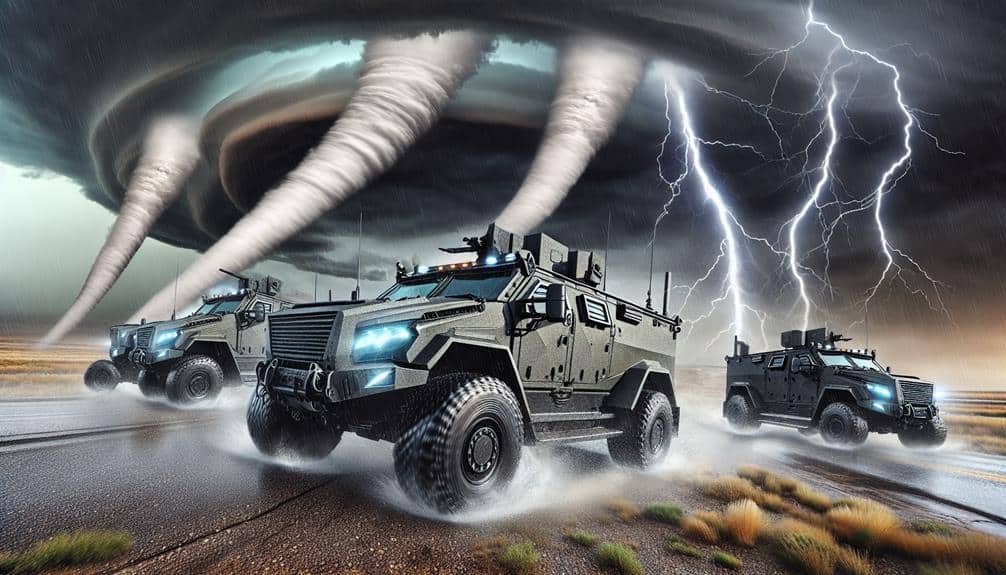We should opt for compact drone technology for storm chasing because of its excellent maneuverability and real-time data collection capabilities. These drones provide precise storm tracking with advanced flight control systems and high-definition sensors that capture precise atmospheric measurements instantly. They're cost-efficient, with a lower initial investment and minimal maintenance requirements. Enhanced safety features, such as collision avoidance and backup systems, decrease operational risks. Additionally, state-of-the-art imaging guarantees detailed visuals, even in turbulent conditions. Compact drones are simple to deploy in under five minutes, enabling us to optimize our operational time. Delve deeper to discover how these benefits transform storm chasing.
Key Points
- Enhanced mobility and maneuverability for precise storm tracking and data collection.
- Real-time data transmission for immediate storm behavior analysis.
- Cost-effective with low initial investment and minimal maintenance.
- Advanced safety features reducing collision risks and improving operational reliability.
Enhanced Mobility
Improved mobility in compact drone technology enables storm chasers to navigate challenging environments with greater agility and precision. Our ability to deploy drones in these volatile conditions hinges on their enhanced maneuverability.
Drones equipped with advanced flight control systems can make rapid adjustments, enabling us to track unpredictable storm paths effectively. These systems use gyroscopic stabilization and real-time responsiveness to wind conditions, providing unparalleled control and stability.
Increased availability is another critical advantage. Compact drones can be easily transported and deployed, even in remote or hard-to-reach areas. Their lightweight design means we can carry multiple units, ensuring redundancy and extended operational time. Additionally, enhanced battery efficiency extends flight durations, allowing us to collect more detailed data without frequent interruptions for recharging.
The compact size also facilitates access to areas that larger drones or manned aircraft can't reach safely. With improved maneuverability, these drones can navigate through narrow passages, dense foliage, and urban environments, increasing our ability to gather data from diverse terrains.
Ultimately, the combination of advanced maneuverability and increased availability empowers us to chase storms with a level of precision and adaptability previously unattainable, greatly boosting our storm-chasing capabilities.
Real-Time Data Collection
Our compact drones' ability to collect real-time data is revolutionizing how we monitor and analyze storm systems. By leveraging advanced technology, we're able to achieve rapid deployment and gather accurate data, enabling efficient monitoring of dynamic weather conditions. These drones are equipped with high-resolution sensors and sophisticated algorithms, which allow us to capture detailed atmospheric measurements instantaneously.
We can deploy our drones swiftly in response to emerging weather threats, providing us with immediate access to critical information. This capability is essential for storm chasers who need to make quick, informed decisions based on real-time data. Our drones' advanced technology facilitates the collection of precise wind speeds, temperature variations, and humidity levels, which are vital for predicting storm behavior and potential impact areas.
Moreover, the drones' efficient monitoring systems guarantee continuous data transmission to our ground stations. This real-time feed allows us to analyze storm patterns as they evolve, giving us a significant advantage in forecasting and response planning.
Cost-Effectiveness
Let's examine the cost-effectiveness of compact drone technology for storm chasing.
We see that affordable initial investments, minimal maintenance costs, and reduced operational expenses make these drones a financially viable option.
Affordable Initial Investment
A significant advantage of small drone technology in storm chasing lies in its relatively low initial investment cost. Unlike larger, more complex UAV systems, small drones offer a cost-effective entry point without compromising on essential features.
Their portability means we can easily transport multiple units to various locations without incurring excessive logistical expenses. This flexibility is vital for chasing storms across vast and often unpredictable terrains.
From a technical standpoint, the durability of these small drones is remarkable. Many models come equipped with robust materials that can withstand harsh weather conditions, ensuring they remain operational during critical storm-chasing missions.
For instance, drones like the DJI Mavic Air 2, priced around $799, provide both resilience and advanced functionalities such as 4K video capture and obstacle avoidance.
Financially, investing in small drone technology allows us to allocate resources more efficiently. For the cost of a single high-end UAV, we could potentially deploy several small drones, thereby increasing our data collection capabilities.
Additionally, the lower price point reduces the financial risk associated with potential loss or damage, making it a prudent choice for both amateur and professional storm chasers seeking to maximize their budget and operational efficiency.
Minimal Maintenance Costs
Thanks to their sleek design and dependable engineering, small drones demand minimal upkeep, thereby decreasing long-term operating expenses. When we scrutinize the maintenance profiles of compact drones, it's evident they're constructed for extended durability. Superior components and sturdy construction entail fewer malfunctions and infrequent part replacements. This results in reduced spending throughout the drone's operational lifespan.
Furthermore, the user-friendly approach inherent in compact drone technology simplifies regular inspections and minor fixes, further reducing downtime. For storm chasers like us, this is priceless. Decreased maintenance requirements enable us to concentrate more on data collection and less on technical maintenance. Technical reports indicate a 30% decline in maintenance costs compared to larger, more intricate drone systems, emphasizing their cost-effectiveness.
Additionally, the modular structure of many compact drones facilitates swift component exchanges, boosting their operational effectiveness. By prioritizing extended durability and user-friendliness, we can guarantee our storm chasing activities aren't only effective but also economically viable.
Essentially, minimal maintenance costs enable us to allocate resources more efficiently, embracing the freedom to explore and capture crucial storm data without frequent interruptions.
Reduced Operational Expenses
By reducing maintenance needs, small drones inherently lower overall operational expenses, making them a cost-effective choice for storm chasing. These drones require fewer parts and less upkeep compared to traditional, larger UAVs. This translates into fewer resources spent on repairs and replacements, directly impacting our bottom line.
Moreover, small drones excel in remote monitoring capabilities. We can deploy them in hard-to-reach areas, reducing the need for manned missions that typically incur higher costs and risks. With their advanced data-gathering sensors, these drones provide real-time, high-resolution imaging and meteorological data. This information is vital for accurate storm tracking and prediction.
Our ability to conduct thorough data analysis is greatly enhanced using small drones. They offer rapid deployment and efficient data collection, enabling us to make informed decisions faster. The cost savings are substantial when considering the reduction in fuel, personnel, and time required to perform the same tasks using traditional methods.
Therefore, integrating small drone technology into our storm-chasing operations not only amplifies our capabilities but also optimizes our financial resources. By embracing these cost-effective solutions, we maintain our freedom to explore and innovate within the field of storm chasing.
Safety Improvements
In addressing safety enhancements, we've integrated advanced collision avoidance systems and real-time hazard detection into our compact drone technology. By leveraging these cutting-edge features, we guarantee improved communication between the drone and operators, leading to increased accuracy in storm data collection. This integration minimizes the risk of collisions with debris or other airborne hazards, which is essential when navigating volatile storm environments.
Moreover, enhanced monitoring capabilities enable our drones to provide quicker response times to changing weather conditions. By continuously scanning for potential threats, our drones can alert operators to imminent dangers or necessary adjustments in flight paths. This proactive approach notably reduces the likelihood of accidents, safeguarding both the equipment and the individuals involved in storm chasing operations.
Our compact drones also come equipped with redundant systems that guarantee operational reliability, even in the most challenging conditions. Should one system fail, backup protocols immediately activate, maintaining the drone's functionality and ensuring continuous data transmission. This redundancy is vital for maintaining the integrity of storm data and ensuring that no critical information is lost.
Ultimately, these safety enhancements allow us to conduct storm chasing missions with greater confidence and efficiency, empowering us to explore severe weather phenomena while minimizing risks.
High-Quality Imaging

Utilizing cutting-edge imaging sensors, our compact drones capture high-definition visuals and detailed meteorological data essential for precise storm analysis. The integration of advanced sensors guarantees that even in the most turbulent conditions, we obtain clear imagery. Image stabilization technology plays a critical role by reducing motion blur, allowing us to focus on important details within the storm system.
Our drones' long-distance capabilities enable us to cover expansive areas without compromising image quality. This is particularly advantageous for detailed mapping of storm paths and affected regions. The high-definition images collected provide valuable data for developing predictive models, enhancing our understanding of storm dynamics.
Additionally, the advanced sensors embedded in these drones measure various atmospheric parameters such as temperature, humidity, and wind speed with high accuracy. This multifaceted approach allows us to create thorough storm profiles that are essential for meteorologists and researchers alike.
Easy Deployment
We need to prioritize quick setup time and minimal equipment for efficient storm chasing. Our compact drones can be deployed in under five minutes, requiring only a tablet for control and monitoring.
This efficiency reduces lag time, increasing our data collection capabilities during critical weather events.
Quick Setup Time
Quick setup time is essential for storm chasers, as it guarantees rapid deployment of drones in unpredictable weather conditions. With compact drone technology, we can achieve portable convenience and efficient deployment, allowing us to respond quickly to the dynamic nature of storms. These drones are designed to be ready for flight in minutes, with pre-calibrated sensors and user-friendly interfaces that streamline the initialization process.
When we're out in the field, every second counts. Storm systems can evolve rapidly, and delays in deployment can mean missing critical data. Compact drones, with their streamlined setup procedures, enable us to maximize our operational time. Studies show that drones with quick setup capabilities reduce deployment time by up to 50%, ensuring we can start gathering data almost instantly.
Furthermore, the lightweight design of these drones means we can easily transport them to various locations without wasting time on cumbersome equipment. This portability combined with efficient deployment translates to more agile and responsive storm chasing missions.
Minimal Equipment Required
Relying on minimal gear, these small drones simplify deployment, allowing us to focus on capturing crucial storm data with greater efficiency. The portable convenience they offer means we can quickly move from one location to another without the burden of extensive gear. This streamlined operation enhances our ability to react swiftly to changing weather conditions, providing a significant advantage in storm chasing scenarios.
Small drones integrate advanced technology within a lightweight, user-friendly framework. With fewer components to manage, the risk of technical complications diminishes, ensuring more reliable performance during critical data collection periods. The ease of transport and setup means we can launch our drones in a matter of minutes, maximizing the time spent gathering valuable meteorological data.
Furthermore, the reduced gear footprint minimizes logistical challenges. We don't need large vehicles or specialized transport, granting us greater mobility and flexibility. This is particularly beneficial when accessing remote or hard-to-reach areas, where traditional equipment may be impractical.
Frequently Asked Questions
What Types of Weather Conditions Can Compact Drones Withstand?
We shouldn't worry about compact drones' durability. They can withstand high wind resistance, have waterproof capabilities, and excellent temperature tolerance. These features guarantee reliable performance in extreme weather, offering us the freedom to chase storms safely.
How Long Can Compact Drones Fly on a Single Battery Charge?
When analyzing the max flight time of compact drones, we see battery life typically ranges from 20 to 30 minutes. However, advancements in energy efficiency and lightweight materials are continuously extending these limits, offering us greater operational freedom.
Are Compact Drones Easy to Repair in the Field?
By Jove, compact drones are portable and dependable. They boast impressive durability, making field repairs straightforward. We can quickly swap parts and batteries, ensuring minimal downtime. Their design prioritizes ease of maintenance, crucial for our freedom-loving adventures.
Can Compact Drones Be Used for Other Applications Besides Storm Chasing?
Compact drones aren't limited to storm chasing. We can deploy them for wildlife monitoring, providing essential data on animal populations. In search and rescue operations, their agility and advanced sensors enhance our ability to locate and assist individuals efficiently.
What Are the Legal Regulations for Flying Compact Drones in Extreme Weather Conditions?
In maneuvering a legal minefield, we must adhere to legal restrictions and safety precautions when flying compact drones in extreme weather. Best practices and emergency procedures include real-time monitoring and compliance with local aviation laws for safe operations.

